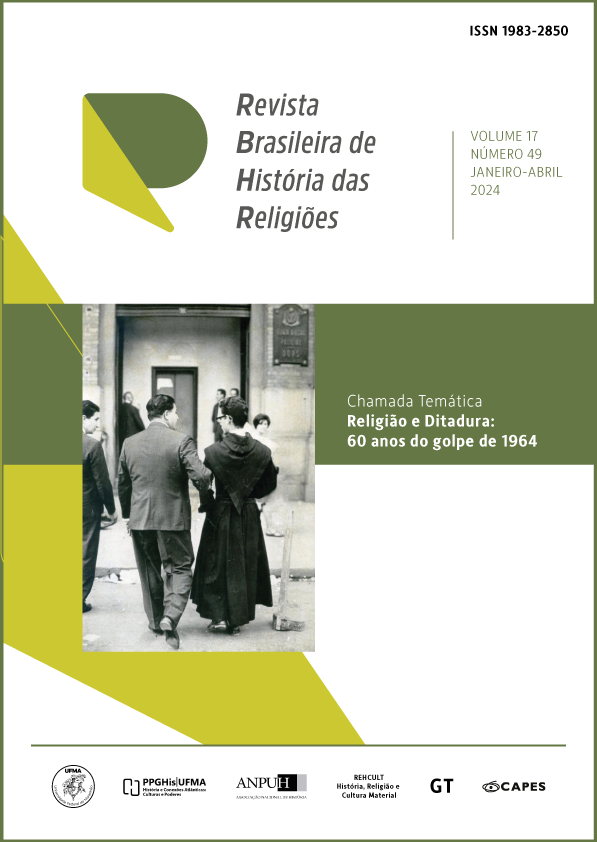The National Sanctuary of Aparecida and the Sesquicentenary of Brazil's Independence in 1972
DOI:
https://doi.org/10.18764/1983-2850v17n49.2024.5Keywords:
Catholic Church, Sesquicentenary of Independence, Aparecida, consensus, civil-military dictatorshipAbstract
The aim of this article is to understand the Catholic Church's participation in the celebrations of the Sesquicentenary of Brazil's Independence in 1972, based on the work of the National Shrine of Our Lady of the Conception of Aparecida. The idea is to reflect on the participation of the Catholic leadership in the Independence celebrations beyond the notion of a “battle for patriotism” which, according to Kenneth Serbin, involved bishops and the military in the context of the most popular festival of the dictatorship. Thus, the article highlights the rapprochement between the clergy of the National Shrine and the Médici government in the name of a civic-patriotic imaginary that, in some way, was synthesized in the image of the patron saint of Brazil and helped to compose the social consensus around the civil-military dictatorship, precisely at the time of the greatest repression.
Downloads
Metrics
References
AARÃO REIS, Daniel. Ditadura e democracia no Brasil: do golpe de 1964 à Constituição de 1988. Rio de Janeiro: Zahar, 2014.
CHAUÍ, Marilena. Brasil: mito fundador e sociedade autoritária. São Paulo: Ed. Fundação Perseu Abramo, 2000.
CORDEIRO, Janaina Martins. A ditadura em tempos de milagre: comemorações, orgulho e consentimento. Rio de Janeiro: Editora FGV, 2015.
______. Comemorar e vigiar: o Sesquicentenário da Independência do Brasil, 1972. In: NUNES, João Paulo Avelãs; ABREU, Luciano Aronne de; SOUZA, Miliandre Garcia de; MAIA, Tatyana de Amaral (Orgs.). A independência e o Brasil independente. v.2. Porto Alegre: EdiPUCRS, 2022, p.305-327.
COSTA, Célia; PANDOLFI, Dulce Chaves; SERBIN, Kenneth (Orgs.). O bispo de Volta Redonda: memórias de dom Waldyr Calheiros. Rio de Janeiro: Editora FGV, 2001.
ESCRIBANO, Francesc. Descalço sobre a terra vermelha. São Paulo: Hucitec, 2000.
FICO, Carlos. Reinventando o otimismo. Ditadura, propaganda e imaginário social no Brasil. Rio de Janeiro: Editora FGV, 1997.
_____. O golpe de 1964: momentos decisivos. Rio de Janeiro: Editora FGV, 2014.
MATHIAS, Mathews Nunes. Nossa Senhora da ditadura: o Santuário Nacional de Aparecida e o regime militar (1963-1972). 2023. Dissertação (mestrado). Universidade Federal Fluminense, Instituto de História, Niterói, 2023.
MORENO, Júlio César. A ação do Santuário Nacional de Nossa Senhora Aparecida e o fomento do Turismo religioso. Tese. (Doutorado em Ciências da Comunicação). Universidade de São Paulo, São Paulo, 2009.
ONGHERO, André Luiz. “O ensino de Educação Moral e Cívica: memórias de professores do Oeste de Santa Catarina (1969-1993)”. In: Revista Horizontes. Bragança Paulista, v. I, 2009.
PRADO, Luiz Carlos Delorme; EARP, Fábio Sá. O “milagre” brasileiro: crescimento acelerado, integração internacional e concentração de renda (1967-1973). In: FERREIRA, Jorge; DELGADO, Lucilia de Almeida Neves (Orgs.). O Brasil republicano. O tempo ditadura: regime militar e movimentos sociais em fins do século XX. 2. ed., vol. 4, Rio de Janeiro: Civilização Brasileira, 2007. p. 207-241.
PRANDINI, Fernando; PETRUCCI, Victor A. e DALE, Romeu (Orgs.). As Relações Igreja- Estado no Brasil. v.3. São Paulo: Loyola, 1988.
SERBIN, Kenneth. Diálogos na sombra: bispos e militares, tortura e justiça social na ditadura. São Paulo: Companhia das Letras, 2001.
Downloads
Published
How to Cite
Issue
Section
License
Copyright (c) 2024 Revista Brasileira de História das Religiões

This work is licensed under a Creative Commons Attribution 3.0 Unported License.












